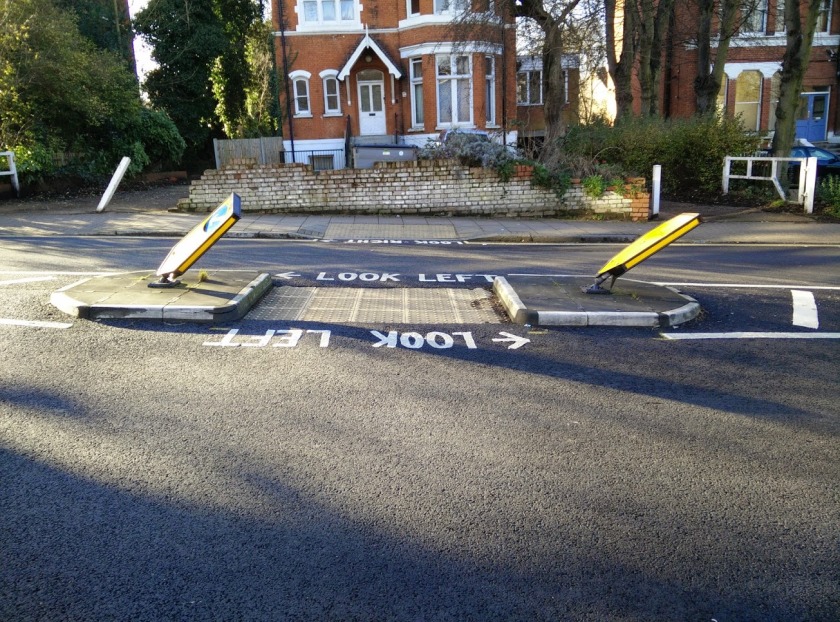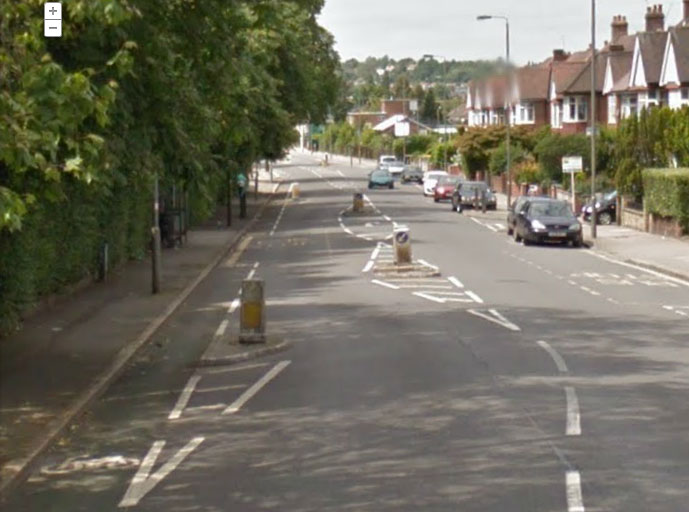As the nights draw in and the clocks go back, it’s time once again for the perennial road safety campaigns to call for cyclists and pedestrians to take their share of responsibility by making sure that they’re visible.
But today I’m delighted to announce another important new road safety campaign.
Because every day when I look around on our streets it is clear to me that it’s not just cyclists and pedestrians who are failing to do their bit by making themselves visible. There is another group of road users who are all too often failing to do their bit.
That’s right, I’m talking about fluorescent yellow illuminated retroflective plastic ‘keep left’ bollards.

This fluorescent yellow illuminated retroreflective bollard should have made itself more visible.

This fluorescent yellow illuminated retroreflective bollard should have made itself more visible.

This fluorescent yellow illuminated retroreflective bollard should have made itself more visible.

This fluorescent yellow illuminated retroreflective bollard should have made itself more visible.

This fluorescent yellow illuminated retroreflective bollard should have made itself more visible.

This fluorescent yellow illuminated retroreflective bollard should have made itself more visible.

All of these fluorescent yellow illuminated retroreflective bollards should have made themselves more visible.

Both of these fluorescent yellow illuminated retroreflective bollards should have made themselves more visible.

This fluorescent yellow illuminated retroreflective bollard should have made itself more visible.

This fluorescent yellow illuminated retroreflective bollard should have made itself more visible.

This fluorescent yellow illuminated retroreflective bollard should have made itself more visible.

This fluorescent yellow illuminated retroreflective bollard should have made itself more visible.

These fluorescent yellow illuminated retroreflective bollards should have made themselves more visible.

This fluorescent yellow illuminated retroreflective bollard should have made itself more visible.

This fluorescent yellow illuminated retroreflective bollard should have made itself more visible.

This fluorescent yellow illuminated retroreflective bollard should have made itself more visible.

This fluorescent yellow illuminated retroreflective bollard should have made itself more visible.

These illuminated retroreflective bollards should have made themselves more visible.

This fluorescent yellow illuminated retroreflective bollard should have made itself more visible.

These illuminated retroreflective bollards should have made themselves more visible.

This fluorescent yellow illuminated retroreflective bollard should have made itself more visible.

This fluorescent yellow illuminated retroreflective bollard should have made itself more visible.
This fluorescent yellow illuminated retroreflective bollard should have made itself more visible.

This fluorescent yellow illuminated retroreflective bollard should have made itself more visible.

This fluorescent yellow illuminated retroreflective bollard should have made itself more visible.

This fluorescent yellow illuminated retroreflective bollard should have made itself more visible.

These fluorescent yellow illuminated retroreflective bollards should have made themselves more visible.

This fluorescent yellow illuminated retroreflective bollard should have made itself more visible.
This fluorescent yellow illuminated retroreflective bollard should have made itself more visible.

This fluorescent yellow illuminated retroreflective bollard should have made itself more visible.

This fluorescent yellow illuminated retroreflective bollard should have made itself more visible.

This fluorescent yellow illuminated retroreflective bollard should have made itself more visible.

This fluorescent yellow illuminated retroreflective bollard should have made itself more visible.
This fluorescent yellow illuminated retroreflective bollard should have made itself more visible.
This fluorescent yellow illuminated retroreflective bollard should have made itself more visible.
This fluorescent yellow illuminated retroreflective bollard should have made itself more visible.

This fluorescent yellow illuminated retroreflective bollard should have made itself more visible.

This fluorescent yellow illuminated retroreflective bollard should have made itself more visible.

This fluorescent yellow illuminated retroreflective bollard should have made itself more visible.

This fluorescent yellow illuminated retroreflective bollard should have made itself more visible.
This fluorescent yellow illuminated retroreflective bollard should have made itself more visible.

This fluorescent yellow illuminated retroreflective bollard should have made itself more visible.

This fluorescent yellow illuminated retroreflective bollard should have made itself more visible.

This fluorescent yellow illuminated retroreflective bollard should have made itself more visible.
This fluorescent yellow illuminated retroreflective bollard should have made itself more visible.

This fluorescent yellow illuminated retroreflective bollard should have made itself more visible.

This fluorescent yellow illuminated retroreflective bollard should have made itself more visible.

This fluorescent yellow illuminated retroreflective bollard should have made itself more visible.

This fluorescent yellow illuminated retroreflective bollard should have made itself more visible.

This fluorescent yellow illuminated retroreflective bollard should have made itself more visible.

This fluorescent yellow illuminated retroreflective bollard should have made itself more visible.
This fluorescent yellow illuminated retroreflective bollard should have made itself more visible.

This fluorescent yellow illuminated retroreflective bollard should have made itself more visible.

This fluorescent yellow illuminated retroreflective bollard should have made itself more visible.

This fluorescent yellow illuminated retroreflective bollard should have made itself more visible.

This fluorescent yellow illuminated retroreflective bollard should have made itself more visible.

This fluorescent yellow illuminated retroreflective bollard should have made itself more visible.
This fluorescent yellow illuminated retroreflective bollard should have made itself more visible.

One of these fluorescent yellow illuminated retroreflective bollards should have made itself more visible.

This fluorescent yellow illuminated retroreflective bollard should have made itself more visible.

This fluorescent yellow illuminated retroreflective bollard should have made itself more visible.

This fluorescent yellow illuminated retroreflective bollard should have made itself more visible.
This fluorescent yellow illuminated retroreflective bollard should have made itself more visible.

This fluorescent yellow illuminated retroreflective bollard should have made itself more visible.

This fluorescent yellow illuminated retroreflective bollard should have made itself more visible.

This fluorescent yellow illuminated retroreflective bollard should have made itself more visible.
This fluorescent yellow illuminated retroreflective bollard should have made itself more visible.

This fluorescent yellow illuminated retroreflective bollard should have made itself more visible.
This fluorescent yellow illuminated retroreflective bollard should have made itself more visible.
This fluorescent yellow illuminated retroreflective bollard should have made itself more visible.
These fluorescent yellow illuminated retroreflective bollards should have made themselves more visible.
This fluorescent yellow illuminated retroreflective bollard should have made itself more visible.
This fluorescent yellow illuminated retroreflective bollard should have made itself more visible.
https://twitter.com/adventuresofrob/status/887372941691932673
This fluorescent yellow illuminated retroreflective bollard should have made itself more visible.
This fluorescent yellow illuminated retroreflective bollard should have made itself more visible.
This fluorescent yellow illuminated retroreflective bollard should have made itself more visible.
This fluorescent yellow illuminated retroreflective bollard should have made itself more visible.
This fluorescent yellow illuminated retroreflective bollard should have made itself more visible.

This fluorescent yellow illuminated retroreflective bollard should have made itself more visible.

This fluorescent yellow illuminated retroreflective bollard should have made itself more visible.

This fluorescent yellow illuminated retroreflective bollard should have made itself more visible.

This fluorescent yellow illuminated retroreflective bollard should have made itself more visible.

This fluorescent yellow illuminated retroreflective bollard still should have made itself more visible.

This fluorescent yellow illuminated retroreflective bollard should have made itself more visible.

This fluorescent yellow illuminated retroreflective bollard should have made itself more visible.

This fluorescent yellow illuminated retroreflective bollard should have made itself more visible.
It’s time fluorescent yellow illuminated retroreflective plastic ‘keep left’ bollards took their share of responsibility on the roads and made themselves more visible.

